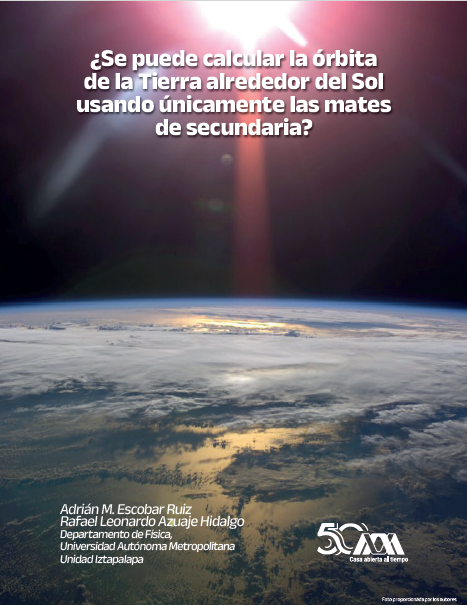¿Se puede calcular la órbita de la Tierra alrededor del Sol usando únicamente las mates de secundaria?
Palabras clave:
solubilidad, sistemas Hamiltonianos, cantidades conservadas, problema de Kepler
Resumen
Desde que el ser humano puede ver las estrellas en el cielo ha querido comprender y describir el movimiento de estas. Actualmente podemos describir de manera matemática el movimiento de objetos celestes, además de otros objetos de la naturaleza. Sin embargo, este conocimiento parece estar restringido a solo físicos y matemáticos expertos en el tema. En este texto presentamos de manera breve y accesible algunas ideas y desarrollos que nos permiten describir el movimiento de ciertos sistemas físicos que encontramos en la naturaleza, entre ellos el movimiento de objetos celestes, usando solo las herramientas matemáticas que se enseñan regularmente en secundaria.
Descargas
La descarga de datos todavía no está disponible.
Citas
Abraham R. and Marsden J. E., Foundations of Mechanics. American Mathematical Soc. No. 364, pp 161-199, 2008.
Arnold V. I., Kozlov V. V. and Neishtadt A. I, Mathematical Aspects of Classical and Celestial Mechanics, Third Edition. Springer, pp 30-40, 2006.
Azuaje R., "Solutions of the Hamilton equations for time-dependent Hamiltonian systems by means of solvable Lie algebras of symmetries", Rep. Math. Phys., 89(2), pp. 221–230, 2022.
Escobar-Ruiz A. M. and Azuaje R., "On particular integrability in classical mechanics", J. Phys. A: Math. Theor. 57 105202, 2023.
Escobar-Ruiz A. M., Linares R. and Winternitz P., "New infinite families of Nth-order superintegrable systems separating in Cartesian coordinates", J. Phys. A: Math. Theor. 53 445203, 2020.
Goldstein H., Classical mechanics. Pearson Education, pp. 334-366, 2011.
Miller W. et al., "Classical and quantum superintegrability with applications", J. Phys. A: Math. Theor. 46 423001, 2013.
Turbiner A. V. and Escobar-Ruiz A. M., "Two-body Coulomb problem and hidden g (2) algebra: superintegrability and cubic polynomial algebra", Journal of Physics: Conference Series. Vol. 2667. 012075, 2023.
Arnold V. I., Kozlov V. V. and Neishtadt A. I, Mathematical Aspects of Classical and Celestial Mechanics, Third Edition. Springer, pp 30-40, 2006.
Azuaje R., "Solutions of the Hamilton equations for time-dependent Hamiltonian systems by means of solvable Lie algebras of symmetries", Rep. Math. Phys., 89(2), pp. 221–230, 2022.
Escobar-Ruiz A. M. and Azuaje R., "On particular integrability in classical mechanics", J. Phys. A: Math. Theor. 57 105202, 2023.
Escobar-Ruiz A. M., Linares R. and Winternitz P., "New infinite families of Nth-order superintegrable systems separating in Cartesian coordinates", J. Phys. A: Math. Theor. 53 445203, 2020.
Goldstein H., Classical mechanics. Pearson Education, pp. 334-366, 2011.
Miller W. et al., "Classical and quantum superintegrability with applications", J. Phys. A: Math. Theor. 46 423001, 2013.
Turbiner A. V. and Escobar-Ruiz A. M., "Two-body Coulomb problem and hidden g (2) algebra: superintegrability and cubic polynomial algebra", Journal of Physics: Conference Series. Vol. 2667. 012075, 2023.

Publicado
2024-12-19
Cómo citar
Escobar Ruiz, A. M., & Azuaje Hidalgo, R. L. (2024). ¿Se puede calcular la órbita de la Tierra alrededor del Sol usando únicamente las mates de secundaria?. Contactos, Revista De Educación En Ciencias E Ingeniería, (139), 72 - 81. Recuperado a partir de https://contactos.izt.uam.mx/index.php/contactos/article/view/470
Sección
Artículos





